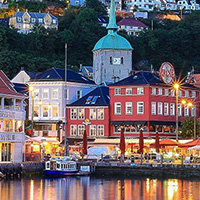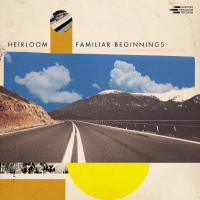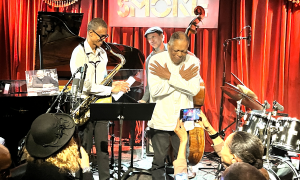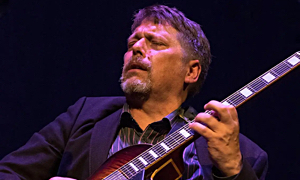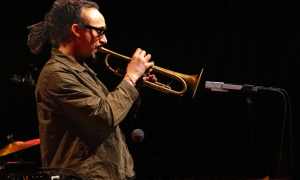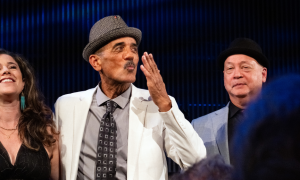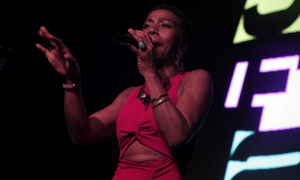Home » Jazz Articles » Live Review » Norwegian Road Trip, Part 7: Molde Jazz, Days 5-6
Norwegian Road Trip, Part 7: Molde Jazz, Days 5-6
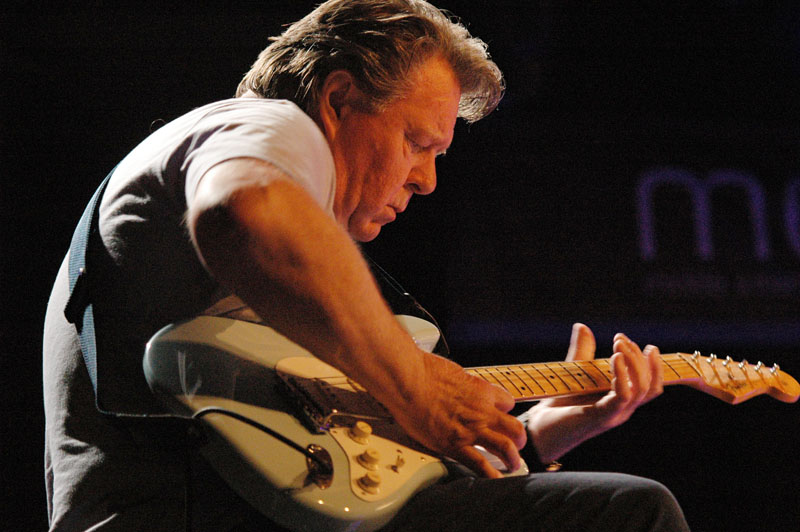
[Editors Note: From July 6 to July 26, 2010, All About Jazz Managing Editor John Kelman will travel throughout Norway to cover both the Kongsberg Jazz Festival (also participating in Silver City Sounds) and Molde Jazz. He'll also spend a week between the two famous festivals in Oslo, where he'll check out the scene, talk to musicians and labels, and visit the legendary Rainbow Studio for a look around and an interview with engineer Jan Erik Kongshaug, who has participated in hundreds of ECM recordings. He'll publish every second or third day, so be sure to follow him as he goes from the east coast to the west, in search of Norwegian artists known and unknown].
As the rain stopped and the clouds cleared in Molde, Norway, the change in weather wasn't just a relief for not having to run around with an umbrella and coat; it was finally possible to see some of the 222 mountains that surround Molde. Even on a clear day, every turn of the eye seems to yield a new peak, from glorious green to stark and snow-capped. With the weather forecast for the next few days meant to be sunny and clear, it couldn't be better to experience the final days of Molde Jazz 2010, and this extended Norwegian Road Trip. It's been an unforgettable experience for places visited, people met and music heard; but it's also time to get back home to family, as three weeks is a long time to be away.
But meanwhile, in addition to all the good experiences at Molde, some fantastic news. On Friday, July 23, just before Motorpsycho's show with Trondeimsolistene and Trondheim Jazz Orchestra, guitarist Stian Westerhus—who has been all over Molde this year, performing with trumpeter Nils Petter Molvaer's Trio, and with his own collective Puma, and will be heard on the festival's final day in duet with vocalist Sidsel Endresen—was awarded the Sparebank 1 JazZtipendiat 2010, a 250,000 NOK commission to write and perform a piece at Molde Jazz 2011, also with the Trondheim Jazz Orchestra. As his significance becomes increasingly evident, seemingly with every passing day, it's hard to predict what this collaboration will sound like, but there's no doubt that, were it Molde Jazz 2011's only performance, it would be reason enough to make the long trek from Canada, back to this place where stunning landscapes provide the perfect backdrop—and the perfect inspiration—for so much remarkable, cutting-edge music.
There was also an opportunity to visit Molde's art gallery, where an exhibition of the artwork for Rune Grammofon—the festival's first Label in Residence—was in progress. For a label that's about to release its one hundredth release this fall, it stands alone in not only having a very specific artistic design aesthetic, but one that's been delivered by a single artist—Kim Hiorthøy.
With one wall devoted to every single CD cover published to date, another to the actual CDs (which have absolutely nothing written on them; just a unique color to differentiate one from another), a wall with all the vinyl gatefold sleeves the label has released (and it's releasing vinyl with increasing regularity, on top of launching The Last Record Company, a vinyl-only imprint, in 2009), and a room with some additional larger- scale artwork, by collecting of all Hiorthøy's work together in one place it makes clear the significance of his work, and that of label owner Rune Kristoffersen, interviewed the previous week in Oslo. That Rune Grammofon titles are beginning to get greater visibility in mainstream publications like Rolling Stone and Stereophile, alongside complete ongoing coverage with AllAboutJazz.com, suggests, perhaps, that the label which broke new ground with the release of Supersilent's three-disc debut in 1997, 1-3, may not be compromising its forward-thinking objectives in any way, but is gradually gaining ground as a label far more visible on the popular radar than ever before.
Chapter Index
- July 23: Motorpsycho/Trondheimsolistene/Trondheim Jazz Orchestra
- July 24: Nils Petter Molvær , "Break of Day," with Biosphere
- July 24: Espen Eriksen Trio
- July 24: Terje Rypdal/Miroslav Vitous/Gerald Cleaver
- July 24: Sidsel Endresen/Stian Westerhus
- July 25: Ending the Trip with The Atlantic Road
July 23: Motorpsycho/Trondheimsolistene/Trondheim Jazz Orchestra
It was easy to understand why Motorpsycho's Molde Jazz 2010 show was so hotly anticipated. Together for more than 20 years, Motorpsycho is one of Norway's most successful longstanding rock groups, one that's shifted its emphasis organically over the years. While original bassist Bent Sæther and guitarist Hans Magnus Ryan didn't grow up in the days of Rush, Led Zeppelin, King Crimson (well, the original incarnation), Soft Machine or Hatfield and the North, all these groups and more have run as undercurrents to the group at various times. Motorpsycho's latest release, Heavy Metal Fruit (Rune Grammofon, 2010), combines metal-tinged prog, space-rock jams, and passages of reckless abandon, all delivered through epic writing, thunderous grooves, and layered guitars.
And that would have been enough to create a buzz for its Molde performance. But add to that the participation of the Trondheim Jazz Orchestra (with a bevy of well-known soloists), the Trondheimsolistene (a group of string players) and, even more importantly, the direction of keyboardist Ståle Storløkken, and the group's show at the Romsdalmuseet (Romsdal Museum)—a long walk uphill from the town center—was a recipe for one of the festival's biggest creative successes of 2010. That the members of Motorpsycho can't read music was all the more remarkable for its ability to navigate Storløkken's detailed arrangements—providing plenty of vamp-based solo spots for various members of the collective ensemble, but also leaning heavily on complexity, albeit never with the sense of gravitas that "rock group meets orchestra" projects often demonstrate; a clear but, perhaps, less-than-obvious reference to the British Canterbury scene.
In conversation the afternoon of the performance, Sæther was self- deprecatingly dismissive of the group's actual input to the set list—talking about material that the group had lying around but never fully developed and some vamps that would be good for jazz soloists. But the combination of Motorpsycho—also including relatively recent recruit, drummer Kenneth Kapstad (who Artist in Residence/trumpeter Nils Petter Molvaer called "fucking fantastic" from the side of the stage, early in the performance)—and Storløkken, who fleshed out the group's music with stunning diversity, resulted in a set of music that may have had its roots in the rock world, but also easily crossed over into the worlds of jazz and contemporary music.
If Soft Machine had worked with a five-piece horn section, nine-piece string section and violin soloist, it might have sounded something like Motorpsycho's 90- minute set. Sæther, playing an atypical Guild semi-hollow body electric bass, delivered fuzz-toned lines reminiscent of Soft Machine's Hugh Hopper. And while Storløkken didn't have Soft Machine's defining Lowry organ (using, instead, a Hammond), he did have a Fender Rhodes electric piano and Mini Moog to create a sound that was, at least, in the ballpark. Between Sæther's relentless, irregular-metered riffs, Kapstad's fluid yet powerful drumming, and Storløkken's imaginative horn and string arrangements, the excitement continued to build, even as the group vamped for long periods of time as a foundation for solos from violinist Ola Kvernberg, trombonist Mats Äleklint and Albatrosh saxophonist André Roligheten that lifted the performance to some of its greatest heights.
Storløkken—best known for his work with Supersilent, Terje Rypdal's Skywards trio and his own Elephant9—created an overriding arc that created dramatic climaxes and unexpected respites. After a visceral build where Sæther and Kapstad created a grungy but unshakable underpinning for a screaming solo from Ryan, everything suddenly stopped, leaving the Trondheim Solistene on its own for a scored section of amorphous string work that gradually took shape as the horns—two saxophones, two trombones (including The Source's Øyvind Brække) and two trumpets (including Mathias Eick—ultimately entered for another sonic build of contrapuntal surprises and unexpected textures. There was a time when the idea of a rock group working with strings either meant saccharine or dysfunction, but here the integration was as seamless and natural as could be. Heavily scored sections suddenly broke into headbanging, hard rock, and yet the two never seemed out of context with each other, as even the string section—largely dressed more reservedly than Motorpsycho's long-haired guitarist and bassist—could be seen bobbing their heads in time with Sæther and Kapstad's thundering pulse.
Kvernberg—whose show the previous night at Kulturhuset was another festival high point—was a featured soloist throughout the set, delivering time after time with the kind of reckless abandon that's positioning him one of the most exciting young violinists on this, or any, scene. Eick's feature was equally compelling, as was Äleklint's- -a Swedish ringer for Trondheim Jazz Orchestra, but someone who is definitely worth keeping an eye on. And while he was, more often than not, occupied conducting the large ensemble and contributing accompaniment that fleshed Motorpsycho out to a powerhouse quartet, Storløkken did manage to squeeze in a couple of set-defining solos, including a lengthy turn towards the main set's end that was as good as he's ever been...and that's saying something.
The show ended with a funkified encore that featured a driving, contrapuntal horn arrangement, as members of the group gradually left the stage, still playing. Even after they walked down the stairs behind the stage to the backstage area, they continued to play and modulate; a group that clearly was having a great time and didn't want it to end. That enthusiasm—which carried over to a backstage after-show party fueled by food and drink—was impossible to miss by the enthusiastic crowd, making for a final show at Romsdalmuseet that may not have had the star power of some of its earlier shows, including Missy Elliott, Sonny Rollins, Jeff Beck and Herbie Hancock, but will surely go down as the venue's most memorable set of Molde Jazz 2010.
July 24: Nils Petter Molvær , "Break of Day," with Biosphere
With Molde Jazz a festival that always runs into the wee hours of the morning—looking nowhere else than Alexandra Park, across the street from the festival hotel, where dance and party music continues at high volume until well after 2AM each morning—it's hard to believe that approximately 1,200 people made the trek up the road towards Romsdalmuseet to an open air amphitheatre, where Nils Petter Molvær delivered his "Break of Day" concert at 7:00AM. Last year, Artist in Residence Arve Henriksen had a crowd of about 1,000 people doing their morning exercises, as part of a show that included keyboardist Jon Balke, cellist Svante Henryson, percussionist Terje Isungset and a dancer; for Molde Jazz 2010, Molvær's approach was more meditative, contemplative and, ultimately, transcendent. There was free coffee and a variety of other items for sale; one more event that has made Molde Jazz into a festival unlike any other.
The stage was much sparser than Henriksen's, with only Molvær's small rig of laptop and footpedals, and a table with another laptop and keyboard for Biosphere, the name used by Tromsø electronic musician Geir Jenssen on albums including Dropsonde (Touch, 2006) and Nordheim Transformed (Rune Grammofon, 1998), where the he collaborated with Helge Sten (aka Deathprod) on some innovative remixes of the work of groundbreaking Norwegian electronic composer Arne Nordheim.
With the sun up, but not yet over the trees in the amphitheatre, Molvær and Biosphere took to the stage, with Molvær looking up at the full house, shaking his head in amazement—most there had only a very few hours' sleep, if any at all—and simply said, "Good morning." Beginning in electric stasis, with Biosphere creating a gentle wash of sound that somehow evoked imagery of a dawn yet to come, Molvær began weaving slow, gentle lines, harmonized via a pitch shifter, with the harmonic interval adjusted via a foot pedal that raised it a semi-tone when the pedal was depressed, and dropped it again when it was raised. With a view of the fjord poking through the trees, the music was hypnotic, but absolutely compelling; lulling many into a transcendent state that worked perfectly with the early morning hour.
With Molvær's horn being sampled, Biosphere created loops from small phrasal fragments, as the music gradually began to grow, coalesce and assume a pulse, with Molvær's distinctive embouchure creating a timbre that worked well both acoustically and as a source for additional processing. While the overall ambience was easy on the ears, there were brief passages of a more oblique and angular nature, with Molvær eschewing the more extreme work of his trio performance a couple nights' previous, but nevertheless finding ways to work greater freedom into the mix. Still, his playing was relaxed and melodic, even as those melodies were unmistakable with a kind of resonant melancholy. Biosphere took the music into the stratosphere with more otherworldly textures as he sampled long notes played on trumpet, pulled them down to a much lower pitch and then, gradually raising the pitch again, mining interference beats as the notes converged.
As the sun finally rose up over the trees—shedding light on both Molvær and Biosphere, and providing a glorious, shimmering view of the fjord and the mountains beyond—the music moved in and out of shape, and in and out of defined pulse, with Biosphere intuitively breaking the rhythms briefly, raising the tension and begging for release, even as Molvær entered into a solo segment where, singing into the microphone in the bell of his horn, he delivered a more subdued and understated version of solo passages he gave at his trio performance and opening performance at the start of the festival— now only six days past, but somehow feeling like so much more. With so much music, played in such a stunning locale, time seemed to stretch, becoming somehow pliant and surreal; a feeling made all the more profound by Molvær's "Break of Dawn" performance where, rather than leaving his audience energized, he left them thoroughly relaxed; the perfect entry point for Molde's busy final day.
July 24: Espen Eriksen Trio
With the release of pianist Espen Eriksen and his trio's You Had Me at Goodbye (2010), the Norwegian Rune Grammofon label delivered an album that, for those more accustomed to its edgier experimentations, might have seemed somewhat antithetical to its normal modus operandi. Still, discussions with label owner Rune Kristoffersen at Molde and in Oslo the previous week yielded a deeper understanding. Rune has a clear aesthetic— especially in the design work of artist Kim Hiorthøy, but musically to try and pigeonhole the label is as much an exercise in futility as looking to define the music of the German ECM label in any similarly reductionist terms. It's hard to find any one word to describe a label that has released music as diverse as Supersilent, Susanna and The Magical Orchestra and Elephant9 and Motorpsycho.
But the music of Espen Eriksen Trio is more overtly melodic than much of the music heard on the label, and its performance at the Forum on Molde Jazz 2010's final day both confirmed its inherent nature and made a case that, in performance, the group has the ability to take the music further than it did in the studio. In The Country was Rune Grammofon's first piano trio, but Espen Eriksen Trio is its first to tie more directly to the jazz piano trio tradition, though its song-like forms and gently insistent approach to rhythm is far distanced from the conventional swing of American jazz orthodoxy.
Opening with the melodically memorable "Anthem" (as does the album), Eriksen, bassist Lars Tormod Jenset and drummer Andreas Bye performed all of You Had Me at Goodbye, stretching the tunes but never in excess and always respectful of the essence of the writing. Eriksen, in conversation during the Kongsberg Jazz Festival two weeks prior, where he was representing NRK (Norwegian Public Broadcasting, where he's an employee), explained that the process of making You Had Me at Goodbye was a long one, with Rune Kristoffersen pushing the pianist to hone the material, and the final shape of the trio only taking form relatively recently, after other musicians had passed through it, only to leave because of an inability to make a more complete commitment.
While there will be inevitable comparisons to e.s.t. in its singable melodies and accessible forms, Eriksen and his trio avoid the overt virtuosity that so defined the late pianist Esbjorn Svensson, bassist Dan Berglund and drummer Magnus Öström, though Jenset did deliver an arco solo, mid-set, that could easily have transferred to e.s.t., had he add the effects that Berglund has used to create a personal sound on double-bass. But Espen Eriksen Trio, unlike e.s.t., is an all-acoustic trio and one that focuses more heavily on subtlety and nuance than contrapuntal complexity and electronic expansiveness. Bye, in particular, was a drummer who called attention to himself by virtue of doing absolutely everything possible not to do so.
Eriksen admitted to being nervous before hitting the stage ("this is Molde," he said), but if there were any pre-show jitters they were impossible to detect, as the group started in a relaxed fashion, only gradually building in energy— and most notably in commitment and total engagement—as the set evolved. The audience's immersion in the music also grew as the set wore on, with louder and louder rounds of applause that, by the show's end, ensured that an encore would be in order. Eriksen was quick to comply, with a short piece from the album—itself relatively short at just over 37 minutes—that was through-composed and a perfect way to end a late afternoon performance that set the stage for the evening to come.
July 24: Terje Rypdal/Miroslav Vitous/Gerald Cleaver
It's been nine months since Terje Rypdal unveiled his new trio, with an old friend and a new one, at the 2009 Enjoy Jazz Festival. With Rypdal truly back after some physical problems, his performance there, and at Bergen's Natt Jazz Festival a few months earlier—where he recorded the music for his latest CD, Crime Scene (ECM, 2010)—the legendary Norwegian guitarist played better than he had in years; better, perhaps, than he ever had. Still, Rypdal's first performance with Czech bassist Miroslav Vitous and drummer Gerald Cleaver was not without its problems.
The biggest problem was that, despite everyone playing well, Rypdal seemed to be the one who was truly listening, with Vitous, in particular, seeming to compete for the spotlight in a group where collectivity should always transcend individual virtuosity. Nearly a year later, and with a couple of recent dates in Europe under its belt, rather than sounding like three people playing together, Rypdal, Vitous and Cleaver sounded like a band. There was plenty of solo opportunity for everyone, but there was a greater sense that everyone was truly listening.
There was also even greater energy, with Rypdal, in particular, playing as though his life depended on it. From the opener, which harkened back to Rypdal's days with The Chasers and albums like Chaser (ECM, 1985) and Blue (ECM, 1987), but with more fluid, less rock-centric support from Vitous and Cleaver. As part of the "big four," alongside saxophonist Jan Garbarek, bassist Arild Andersen and drummer Jon Christensen, Rypdal's playing has long defined the "Nordic Sound," though at this late stage it's hard to know if he actually evokes images of icy fjords or his playing has simply become associated with them by virtue of his living where he does. Learning that Rypdal lives, in fact, on an island in the fjord where Molde is situated, only furthers the feeling that his music is inexorably tied to the place where he lives.
But regardless of the "chicken and egg" question surrounding how Rypdal's music curiously contains both ice and fire, his playing at Kulturhuset was, quite simply, the best playing heard in years—better, in fact, than anything since the mid-'80s, with the possible exception of his remarkable (and aptly titled) If Mountains Could Sing (ECM, 1995). Fingers flying around the frets, building ascending lines where he pushed his high-end notes even higher with equally ascending harmony notes on the lower strings of his Stratocaster, Rypdal seared, swooped and soared; his distinctive whammy bar-work and singing tone contrasting with densely distorted chords. Fed through a Marshall stack and his usual Vox AC-30, Rypdal's guitar seemed as always on the edge of harmonic feedback, which he controlled with masterful precision. Reckless abandon combined with absolute focus to create music that was visceral yet beautiful; lyrical yet angular; and absolutely exhilarating for the entire 90 minutes.
Vitous came with the orchestral sample library that he innovated in the 1980s, but his ability to trigger samples on material reprised from the Mannheim concert last year as well as on new compositions was even more seamless; his arco tone absolutely distinctive, with the occasional touch of wah filtered in; his pizzicato as rapid- fire as ever. But while it felt as though he was fighting, to some extent, with Rypdal at the Enjoy Jazz ECM 40th Anniversary mini-festival, here he played a more supportive role when Rypdal was at the forefront; pushing and pulling with the guitarist rather than vying for the spotlight.
Some of Vitous' best work can be found on ECM—irrespective of his better- known albums as co-founder of fusion super group Weather Report— including albums like First Meeting (1980), Atmos (1992) and , of course, the two albums he recorded with Rypdal and drummer Jack DeJohnette: Terje Rypdal/Miroslav Vitous/Jack DeJohnette (1979); and To Be Continued (1981). If this trio's Molde performance was any indication, in particular in its evolution towards a true group sound, then it absolutely needs to be recorded, although Rypdal explained, in a brief chat before the show, that first up will be an album where the guitarist has collaborated with the Hilliard Ensemble, soon to be heard in a reunion with Jan Garbarek on Officium Novum (2010).
Cleaver was also in better form than at his Mannheim performance, though his reliance on a very wet, heavily reverbed sound was sometimes excessive, removing much of the clarity, especially when he moved to mallets. But his ability to combine groove and rubato freedom—eyes constantly on both Rypdal and Vitous—contributed to the sense of freedom with which the trio approached the music. Employing hand percussion on one song, he expanded the trio's audioscape while retaining an at-times cymbal-heavy approach that harkened back to Rypdal and Vitous' work with DeJohnette without imitating it.
But as strong as both Vitous and Cleaver were—and as much as they now seemed better in pursuit of a collective sound—it was hard to deny Rypdal's position as star of the show. There's simply no other guitarist in the world who sounds like he does; combining a more expansive harmonic knowledge and unfettered sense of freedom with the kind of rock and roll edge that has turned him into a true icon on his instrument. There were a lot of eyes on Rypdal at Kulturhuset, and while there were plenty of non- guitarists (and non-musicians), it was obvious that a lot of aspiring players were in the crowd as well. Rypdal's performance will, no doubt, go down as one of Molde 2010's most thrilling individual instrumental performances; a true sign that the guitar icon is fully back, his creative juices thoroughly recharged and ready for anything.
July 24: Sidsel Endresen/Stian Westerhus
If Terje Rypdal's performance announced that a guitar icon was back, Stian Westerhus' three festival shows—first, with Nils Petter Molvær's trio, then with Puma, and, finally, as Molde Jazz 2010 drew to a close, in duet with singer Sidsel Endresen—was a solid declaration that there's a new legend in the making; a feeling clearly supported by his winning the 250,000 NOK Sparebank 1 JazZtipendiat 2010 award. Westerhus and Endresen first performed a short encore together, following a double bill of solo performances in Oslo in 2009, and it went so well that the two intrepid explorers felt that further exploration was warranted.
The duo's Molde performance was its first full-length show, and it couldn't have gone better. Endresen, beginning in more conventional territory in the '80s but, through a series of albums—first on ECM with the acoustic but innovative So I Write (1990), moving into more sophisticated electronic territory with Undertow (Jazzland, 2000) and, most recently, documenting the beginning of a completely new approach to voice as instrument on One (Sofa, 2006) that was further developed on Live Remixes, Vol. 1 (Jazzland, 2008)—positioning herself as one of the most distinctive vocalists in the world, Endresen could, on paper, seem to be both an odd choice to partner with Westerhus...but also the ideal one. Endresen's entire approach is based on an acoustic reduction of singing into the smallest of cells that, gradually honed, build into a completely new vocal vernacular; Westerhus' instrument is as much about the array of effects processors that he feeds it through as it is the extended techniques he employs. Endresen is, in relative terms, a quiet performer; Westerhus is nothing, if not loud (though he does understand the meaning of space and quiet).
But the two artists' commitment to unorthodoxy and free-spirited improvisation makes them the perfect partners, each listening with big ears and even bigger hearts, as their set commenced with Endresen sounding as if she were in conversation, but with a language that—stuttering, starting/stopping and jumping back to repeat the briefest phrases—was entirely her own, and though emulating speech, possessed a clear cadence, an unmistakable musicality. Heard in this relatively quiet context, Westerhus' almost instantaneous engagement brought a combination of strange sonorities and the occasional harmonic center, as he used a pair of alligator clips to prepare his slim line Gibson hollow body electric guitar, still fed through the numerous amplifiers and effects processors that took up a large part of the stage at Forum, and gave him the flexibility of moving from a whisper to a thundering, crunching roar in a nanosecond.
Despite its all-improvised nature, the set seemed to move through a series of episodes that, rather than representing explicit cueing, were the result of the kind of instantaneous responsiveness that both artists have demonstrated in other contexts. Surprisingly (or, perhaps, not so surprisingly), Endresen handled herself well when Westerhus began cranking up the volume and intensity; responding with a rare combination of staggering vocal gymnastics (but never without an absolute purpose) and the rich singing voice that she's had all along, as she moved from jittering, reverse-attack articulations to resonant melodism, moving with Westerhus' shifting harmonic center (and, at times, no harmonic center; more sound and texture than notes and chords), but also providing a clear focus for Westerhus, who has proven himself, all week, to be an intuitive player, regardless of the context. With, perhaps, the best chance to watch him at work with his pedals, it became clear just how absolute his knowledge of them is, both individually and in concert together.
If the chemistry that Endresen and Westerhus demonstrated in this, their first full show as a duo, then how they'll be when they perform at Punkt in Kristiasand, five weeks from now, is anybody's guess. Most important, of course, is that they'll not be able to predict how that set will be, and that's exactly as it should be.
July 25: Ending the Trip with The Atlantic Road
With Molde Jazz 2010 over, and the town demonstrating almost no signs of it the following morning—most of the kiosks down from the main street, there was one last thing to do. Atlanterhavsveien (The Atlantic Road), about 50 kilometers outside of Molde, is an award-winning stretch of road that connects the island of Averøy to Vevang, Eide, on the mainland; by extension, the road connects the cities of Kristiansund and Molde.
Driving through the mountains outside Molde to reach the road, it becomes clear just how spread out the population of Norway is. Not a mile goes by where there isn't some sign of life, whether it's a collection of homes or a single hunting shack, which is normally on the property of the owner, signifying that there's a home somewhere else on the land. Rolling mountains, ranging in height from a few hundred meters to nearly two thousand, provide a wealth of hiking and rock climbing opportunities for a population connected to nature in ways that North Americans, as a general rule, are not. Even in the midst of summer, some of the peaks still show snow near the top, and skiing is still possible on some of them.
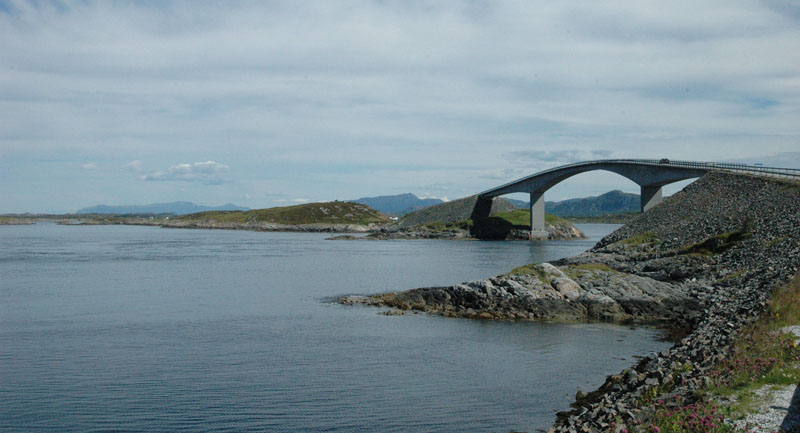
But all things change and become even more impressive when the bridges that span the islands begin to loom in the distance. Approaching the first bridge, it looks more like a ski jump than a bridge, but that's just perspective. Begin to drive on the bridge, and the natural curve that shapes the bridge into a hill that mirrors the rolling scenery around it, and the vista opens up. With the entire three-week Norwegian Road Trip coming to an end, it's hard to pick where the most beautiful spot in Norway is, in a journey that began on the east coast and is ending on the west. But with 222 mountains surrounding it, and The Atlantic Road not far from it, Molde and its surrounding area certainly jumps out as one of the country's most appealing locales.
That there are prisons, factories and other signs of normal habitation only proves how well the Norwegian culture aims to integrate with its geography. There are urban issues in larger centers like Oslo, to be sure; but overall there's a certain sense of harmony that's tremendously appealing. And there's another truth: that it's impossible to separate the music of a country from its culture, and from its geography. It's a certainty that were Norway a different country, with a different climate and different latitude—as opposed to a latitude where, only a little farther north than Molde, you're into the Land of the Midnight Sun—the music that comes from it would absolutely be significantly different.
Music is, after all, a fundamental reflection of who we are and where we live, and if three weeks traveling Norway have taught any one thing, it's that these things are, indeed, absolutely inseparable. With Kongsberg, Oslo and Molde now in the past, the hope is to try and retain some of the scenery, the unique cultural perspective and the vibe that has turned Norway into a country with a music scene like no other.
Visit Motorpsycho, Trondheim Jazz Orchestra, Trondheimsolistene, Nils Petter Molvær, Biosphere, Espen Eriksen Trio, Terje Rypdal, Miroslav Vitous, Gerald Cleaver, Stian Westerhus, Sidsel Endresen and Molde Jazz on the web.
Photo Credits
All Photos: John Kelman
Part 1 | Part 2 | Part 3 | Part 4 | Part 5 | Part 6 | Part 7
Tags
PREVIOUS / NEXT
Support All About Jazz
 All About Jazz has been a pillar of jazz since 1995, championing it as an art form and, more importantly, supporting the musicians who make it. Our enduring commitment has made "AAJ" one of the most culturally important websites of its kind, read by hundreds of thousands of fans, musicians and industry figures every month.
All About Jazz has been a pillar of jazz since 1995, championing it as an art form and, more importantly, supporting the musicians who make it. Our enduring commitment has made "AAJ" one of the most culturally important websites of its kind, read by hundreds of thousands of fans, musicians and industry figures every month.




